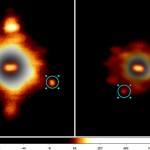W. M. Keck Observatory press release…
After 8 years of observations scientists from the SETI Institute have found an exotic orbit for the largest Trojan asteroid, (624) Hektor—the only one known to possess a moon. The formation of this system made of a dual primary and a small moon is still a mystery, but they found the asteroid could be a captured Kuiper body product of the reshuffling of giant planets in our solar system. The results are being published today in Astrophysical Journal Letters.

In 2006, a small team of astronomers led by Franck Marchis, astronomer at the Carl Sagan center of the SETI Institute, detected the presence of a small 12 km diameter moon around the large Trojan asteroid (624) Hektor. They used the 10 m Keck II telescope atop Mauna Kea, fitted with the NIRC-2 (the Near-Infrared Camera 2) instrument behind the adaptive optics and laser guide star system (LGS-AO).
Continue reading “Distant Asteroid Revealed to be a Complex Mini World”
